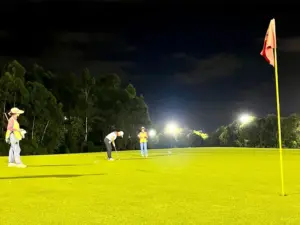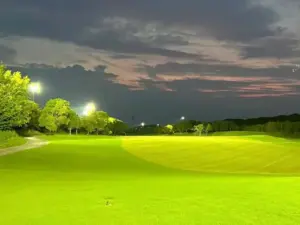Giriş:
Golf course lighting plays a pivotal role in enhancing the aesthetics. It also improves safety and experience for players and spectators alike. When used beyond daylight hours for various events, golf courses can be dangerous. So, adhering to established lighting standards becomes crucial. This article explores the essential aspects of golf courses with light standards. Also, its requirements emphasize the significance of proper illumination for success. It is also suitable for the sustainability of these recreational spaces.
Importance of Golf Course Lighting
Golf, a daytime activity, has evolved to accommodate evening play and events. Adequate lighting ensures that golf courses are safe beyond sunset. It creates new opportunities for revenue generation and community engagement. Moreover, well-designed lighting enhances the visibility of the course. It allows players to navigate fast and maintain a consistent performance level.
Golf Sahası Aydınlatma Standartları ve Gereklilikleri

Safety Considerations
One of the primary objectives of golf lights is to ensure the safety of players. It should also ensure staff and spectators are safe as well. Illumination levels must reduce shadows. They should reduce glare and risk of accidents and enhance visibility. Lighting standards often include guidelines on fixture placement and beam angles. They may also include light distribution to create a safe and enjoyable environment.
Governing Bodies and Standards
Regulatory bodies establish and maintain the lighting standards for golf courses. These are organizations within the lighting industry. The Illuminating Engineering Society (IES) is one of them. The other is the International Dark-Sky Association (IDA). These are two examples of entities that contribute to setting guidelines. They set guidelines for outdoor lighting. These standards encompass illuminance levels, color rendering, and energy efficiency.
Illuminance Levels
Illuminance, measured in lux, is a critical parameter in golf courses with lights. The standards define recommended illuminance levels for different areas of the course. They differ for fairways, greens, and bunkers and depend on various factors. Examples are the type of event, the level of play, and the desired ambiance. Adequate lighting ensures that players can assess distances. It helps them make informed decisions during their rounds.
Color Rendering Index (CRI)
The color rendering index is a measure of light. It tells how a light source illuminates the true colors of objects. In golf lighting, a high CRI is essential. It helps in perceiving the colors of the turf, flags, and hazards. This contributes to a more authentic playing experience. It aids players in making precise shots. Standards often recommend specific CRI values to maintain a natural appearance.
Enerji Verimliliği
For sustainable practices, golf course lighting standards also address energy efficiency. LED technology has become the preferred choice. This is due to its energy-saving capabilities and longevity. Standards may include guidelines on the extent of energy consumption. They may also include fixture types and controls. This is to reduce environmental impact and operational costs.

Lighting Control Systems
Smart lighting control systems are integral to modern golf course lighting designs. These systems enable precise control over the intensity. They also control the timing and direction of the light. It allows for dynamic adjustments based on usage patterns and environmental conditions. Standards may provide recommendations on the implementation of these systems. This is to optimize energy efficiency and enhance flexibility.
Environmental Considerations
Golf courses with lights often occupy expansive areas. So, their lighting installations can have an impact on the surrounding environment. Adherence to lighting standards helps reduce light pollution. It preserves the natural night sky and reduces negative effects on local ecosystems. Shielding fixtures and directing light at required places are common practices. They are there in these standards.
Adaptability to Events
Golf courses host various events, from casual evening rounds to professional tournaments. Hence, golf course lighting standards should address the adaptability of the lighting system. This is to cater to different requirements. Temporary lighting installations for major events may need to follow extra guidelines. This is to ensure optimal visibility and broadcast quality.
FAQs of Golf Course Lighting Standards and Requirements
1. What are the primary reasons for implementing light-up golf course rules on golf courses? What if they are beyond daylight hours?
Golf courses are utilizing lighting for evening play and events. They are creating opportunities for revenue generation and community engagement. Adequate lighting enhances visibility, allowing players to sprint fast. It maintains consistent performance levels during extended hours.
2. How do lighting standards contribute to the safety of golf course users?
Lighting standards play a crucial role in ensuring safety. They do it by minimizing shadows and glare, reducing the risk of accidents. Guidelines on fixture placement, beam angles, and light distribution are vital. They establish to create a safe and enjoyable environment in a light golf range. They help players, staff, and spectators as well.
3. Which organizations are responsible for setting and maintaining golf course lighting standards?
Regulatory bodies and lighting industry organizations. Some are the Illuminating Engineering Society (IES) and (IDA). They contribute to setting guidelines for outdoor lighting. These standards cover illuminance levels, color rendering, and energy efficiency.
4. How does the illuminance level contribute to the golf course lighting design?
Illuminance levels, measured in lux, are critical parameters in golf course lighting. Standards define recommended illuminance levels for different areas of the course. They ensure adequate lighting for fairways, greens, and bunkers. This facilitates accurate assessment of distances and informed decision-making during gameplay.
5. Why is the Color Rendering Index (CRI) an important consideration?
The Color Rendering Index is crucial for perceiving the colors. The turf, flags, and hazards on a golf course are different colors. A high CRI contributes to a more authentic playing experience. It aids players in making precise shots. Lighting standards often recommend specific CRI values. This is to maintain a natural appearance on the course.
Sonuç:
Golf course lighting standards and requirements are essential. They play a pivotal role in shaping the modern golfing experience. They also ensure safety and visibility to embrace energy-efficient technologies. These standards contribute to the sustainable and responsible development of golf courses. By adhering to established guidelines, golf course operators can create great environments. They can cater to diverse needs and promote community engagement. They can also enhance the sport’s allure, extending its enjoyment into the night.
